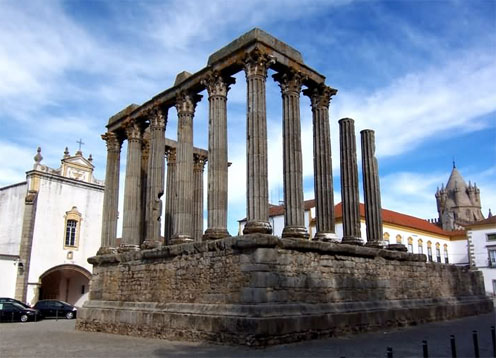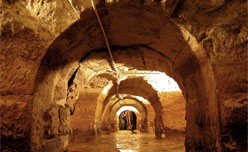Lisbon Roman Galleries
Roman monuments abound in Portugal, which was once, together with the rest of the Iberian Peninsula, an important outpost of the Roman Empire. The temples, roads, bridges, aqueducts build by Romans can be seen in a well preserved stat across all of the country.

The Temple of Diana, in Evora (Alentejo district) is probably one of the most photographed and best preserved Roman monuments in Portugal.
One of the Roman landmarks in Portugal is, however, notoriously left out of the majority of the tourist guides. It is understandable as, one of the lesser known attractions of the Portuguese capital, the Roman Galleries of Lisbon (or Galerias Romanas, in Portuguese) are well hidden underground and open for general public once a year and for a period of 3 days only.
That is due to the fact that the underground structure is normally submersed, being the water pumped out only for a brief period of time, usually in September, allowing the visitors, archaeologists and historians to admire and study this magnific manifestation of the Roman architectural genius.
The silver-lining of a disaster – the discovery of the Roman Galleries
Lisbon is one of the oldest European cities. The first settlements on the grounds of what is currently the Portuguese capital were established as early as in the 8th century BC, when pré-Celtic tribes inhabited the Iberian Peninsula. First fortifications on the hills on the Lisbon Castle, still standing today were dated back to the 2nd century BC.
Much of the nearly 3 thousand year old history of Lisbon, however, remains unknown as the city’s inhabitants built over the ‘old’ structures.
In 1755, the city of Lisbon was struck by an unimaginable tragedy: one of the most powerful earthquakes ever registered, which led to a consequent tsunami and later on, to massive fires that destroyed whatever the earth and ocean hadn’t.
See a historical re-enactment of Lisbon 1755 earthquake:
The triple disaster, although tragic for the city, had a few positive effects, amongst them, a discovery of ancient ruins, buried deep under the ground of the 18th century Lisbon.
The earthquake which proved so destructive for the architecture of the time, not only spared the structures hidden underground, but also made their existence evident.
The underground maze of tunnels proved to be constructed by Romans between 1 BC and 1 AC and gained the name of Roman Galleries – Galerias Romanas in Portuguese.
The function of Lisbon Roman Galleries
One of Lisbon best kept secrets is located under Rua de Prata, the Silver Street in Lisbon Downtown.
The galleries are believed to be a criptoportico, a semi-subterranean, covered structures, whose arched ceilings served as a support to a platform, on which above ground buildings, possibly a Roman forum, were erected.
A system of arched corridors and cells which resisted until today was in the past a part of a much bigger structure, which could have served different purposes, amongst them storage and groundwater drainage. Some findings indicate also that the galleries might have had medicinal function, as some of the ground springs in Lisbon area were considered to have healing properties.
See footage from Lisbon Roman Galleries (in Portuguese):
Visit to the Roman Galleries – practical information
There is no fix dates for opening of the galleries to the general public, although it is most likely to happen in September, when, after the dry Lisbon summer, the underground water level is the lowest. It has happened before, however, that the galleries opened twice a year, also in April. Keep your eyes open to the updated information from a reliable source, for example the Lisbon Tourism Office.
On the day of the opening, queues even 2 blocks long form already in the morning near the entrance to the galleries. Come early to avoid wasting half a day on queuing.
The tours of the galleries are done with a mandatory guide. As a foreigner, make sure you request an English speaking guide. Only Portuguese and English are available.
The entrance to the galleries is through… a hole in the ground on Rua de Prata. The very narrow descent on the steep stairs requires cautiousness, especially taking into consideration the low stone ceilings. Not recommended for people with mobility problems. Or for tourists suffering from claustrophobia. Be prepared for the very narrow passages, darkness and rather damp, at times unpleasantly smelling, air (remember that for most of the year the galleries are totally submersed).
Water resistant shoes/boots are a plus, as often the water dripping from the ceilings forms puddles on the floor.


